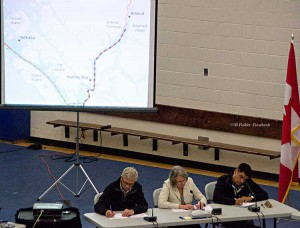
The Haisla Nation in their response to the Crown on the Northern Gateway Joint Review Panel details four studies, three Canadian and one American that were released after the Joint Review evidentiary deadline had passed, evidence that the Haisla say should be considered in any consideration of the Northern Gateway pipeline, terminal and tanker project. (The American report from the National Oceanic And Atmospheric Administration was released after the JRP final report)
JRP chair Sheila Leggett’s constant citing of rules of procedure and her stubborn refusal to consider new evidence and studies in a dynamic situation that was changing rapidly was one of the reasons that many people in the northwest said the JRP had lost credibility.
The Haisla say: “It is incumbent upon Canada to consider and discuss the information in these reports as part of a meaningful consultation process…” and then lists “key findings” that have potential impacts on aboriginal rights and title:
The West Coast Spill response for the government of British Columbia which found:
- Most oil spilled into the marine environment cannot be cleaned up
- There is a disconnect between planning and actual repose capability
- Canada’s spill response is “far from world class.”
The Transport Canada Ship Oil Spill Preparedness and Response study:
- Douglas Channel will go from low risk to high risk for pills if the project goes ahead
- The study recommends preparation for a “true worst case discharge” rather than “the credible worst case discharge” as proposed by Northern Gateway
- Canada needed a much more rigorous regulatory regime covering tankers.
The joint federal government technical report on the properties of bitumen from the Canadian Oil Sands:
- There are uncertainties on how diluted bitumen would behave in a marine environment.
- Northern Gateway did not provide adequate information about sediment levels to allow for proper study of interaction with diluted bitumen
- Dispersant may not be effective.
- Weathered diluted bitumen would “reach densities at which it will sink freshwater without mechanical or physical assistance.”
The US National Oceanic And Atmospheric Administration report on Transporting Alberta Oil sands:
- Diluted bitumen has “significant differences from conventional crudes.’ (The JRP used conventional crude as a benchmark in its findings)
- The physical properties of diluted bitumen “fluctuate based on a number of factors.
- Pipeline operators may not have detailed information related to products in the pipeline at the time of a spill
- There is a lack of experimental data on the weathering behaviour of oil sands product which limits the ability of spill response organizations “to understand and predict the behaviour and fate of oil sands products in freshwater, estuarine and saltwater environments.”
Related
Haisla consultation reply outlines flaws in Northern Gateway Joint Review report